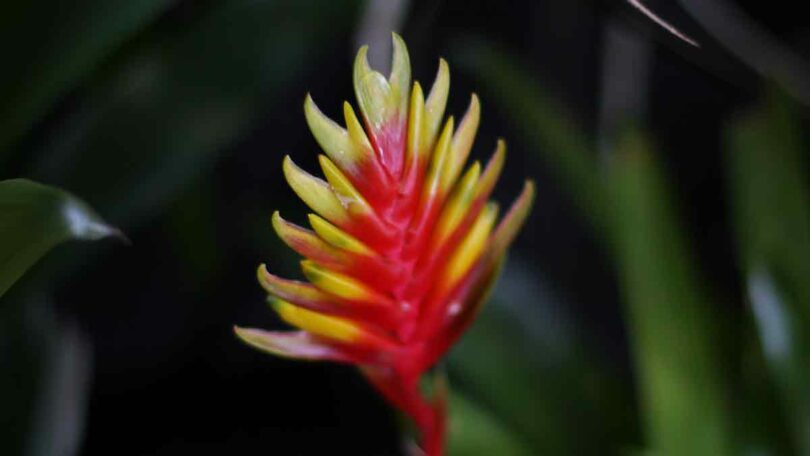
With lots of diversity in the genus Vriesea are a group, many with colourful sword like flowers are popular with collectors and landscapers alike and are an easy care plant.
It is the flower spi, usually orange or red, that gives Vriesea the common name of ‘Flaming Sword Plant’, and they can be grown outdoors or indoors.
With over 240 species including v. ospinae, v. imperialis and v. fosteriana and many cultivars variety is outstanding.
It is Vriesea splendens or ‘Flaming Sword’ that is one of the most popular species with lots of hybrids available.
V. imperialis is an outstanding plant, perhaps not as colorful but the deep maroon flower spike that reaches up to 2m is eye-catching.

How to Grow Vriesea Plants
Originally from Central and South America ( found from Mexico through to Brazil) so when looking at care requirements take into account that they like warmth, indirect light and water.
- Light
Bright filtered light (dappled shade) is best, a few hours of morning sun is OK however hot direct afternoon sun will quickly cause leaf burn.
Many growers use a 50% shade cloth year round.
You can judge the amount of light by the foliage colour. Too much light will cause the foliage to yellow.
Too little light will will give you a deep green foliage. - Soil/Potting Mix
Although many gardeners grow Vriesea in pots, they can also be grown as mounted specimens, usually on bark or tree fern slabs.
A simple soil mix recipe for Vriesea plants is as follows:
50% good quality potting mix
25% medium orchid bark
25% perlite - Watering
Like other bromeliads Vrieseas need to have water in the leaf funnels or rosettes to be happy. Use rain water or distilled/demineralised water to prevent salt build up.
The tank in the centre of the plant needs have water in it, the soil must never be wet and soggy. - Humidity/Temperature
Although they will grow well in cooler climates than the natural habitat, Vrieseas do not like frosts.
Improve humidity by regular mist spraying. Ideal daytime temperature will be between 20° an 30° C. - Fertiliser
Look for a low nitrogen high potassium fertiliser for best flowers.


Propagation
Vrieseas may be grown from seed, however it is usually bt division of pups from the mother plant, this may take a few years to flower, but are well worth the wait.
As the flower die back, the plant will go into the reproduction cycle, it will produce offsets around the base of the plant, these can be removed and planted into seperate pots.
Wait until the pups or ‘offsets’ reach a good size before removing them. When repotting, use a small pot
Vriesea species include
With so many species a few that are worth looking for include V. gigantea from eastern Brazil, this is both epiphytic and terrestrial and is found in coastal rain forests to an altitude of 500m.
Others include :V. splendens, V. imperialis, V. racinae, V. hieroglyphica – a fascinating species with variegated green and yellow foliage, V. duvaliana and V. christiane
Further Information

